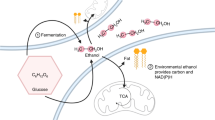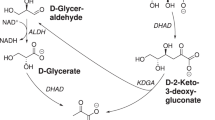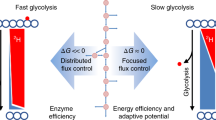Abstract
A new in vitro enzymatic pathway for the generation of molecular hydrogen from glucose has been demonstrated. The reaction is based on the oxidation of glucose by Thermoplasma acidophilum glucose dehydrogenase with the concomitant oxidation of NADPH by Pyrococcus furiosus hydrogenase. Stoichiometric yields of hydrogen were produced from glucose with the continuous recycling of cofactor. This simple system may provide a method for the biological production of hydrogen from renewable sources. In addition, the other product of this reaction, gluconic acid, is a high-value chemical commodity.
This is a preview of subscription content, access via your institution
Access options
Subscribe to this journal
Receive 12 print issues and online access
$209.00 per year
only $17.42 per issue
Buy this article
- Purchase on Springer Link
- Instant access to full article PDF
Prices may be subject to local taxes which are calculated during checkout
Similar content being viewed by others
References
Lepkowski, W. 1995. The Politics of Hydrogen. Chem. & Eng. News 73: 26–49.
Lawler, A. 1995. Walker Bill to boost hydrogen sparks democratic grumbling. Science 267: 613.
Lee, J.W. and Greenbaum, E. 1995. Bioelectronics and biometallocatalysis for production of fuels and chemicals by photosynthetic water splitting. Appl. Biochem. Biotechnol. 51/52: 295–305.
Kitani, O. and Hall, C.W. 1989. Biomass Handbook. Gordon and Breach Science Publishers, New York.
Taguchi, F., Mizukami, N., Yamada, K., Hasegawa, K., and Saito-Taki, T. 1995. Direct conversion of cellulosic materials to hydrogen by Clostridium sp. strain no. 2. Enzyme Microb. Technol. 17: 147–150.
Harrison, D.C. 1931. Glucose dehydrogenase: A new oxidising enzyme from animal tissues. Biochem. J. 26: 1016–1027.
Tranulis, M.A., Christopherson, B., and Borrebaek, B. 1994. Glucose dehydrogenase in beef (Bos taurus) and rainbow trout (Oncorhynchus mykiss) liver: a comparative study. Comp. Biochem. Physiol. 109B: 427–435.
Pauly, H.E. and Pfleiderer, G. 1977. Conformational and functional aspects of the reversible dissociation and denatuation of glucose dehydrogenase. Biochemistry 16: 4599–4604.
Smith, L.D., Budgen, N., Bungard, S.J., Danson, M.J., and Hough, D.W. 1989. Purification and characterization of glucose dehydrogenase from the thermoacidophilic Archaebacterium Thermoplasma acidophilum . Biochem. J. 261: 973–977.
Greenbaum, E. 1980. Simultaneous photoproduction of hydrogen and oxygen by photosynthesis. Biotechnol. Bioeng. Symp. 10: 1–14.
Egerer, P., Günther, H., and Simon, H. 1982. On the hydrogen-deuterium exchange reaction catalyzed by the soluble hydrogenase from Alcaligenes eutrophus H16 in the free and immobilized state. Biochim. Biophys. Acta 703: 149–157.
Ma, K., Zhou, Z.H., and Adams, M.W.W. 1994. Hydrogen production from pyruvate by enzymes purified from the hyperthermophilic archaeon, Pyrococcus furiosus: A key role for NADPH. FEMS Microbiol. Lett. 122: 245–250.
Bright, J.R., Byrom, D., Danson, M.J., Hough, D.W., and Towner, P. 1993. Cloning, sequencing and expression of the gene encoding glucose dehydrogenase from the thermophilic Archaeon Thermoplasma acidophilum . Eur. J. Biochem. 211: 549–554.
Bryant, F.O. and Adams, M.W.W. 1989. Characterization of hydrogenase from the hyperthermophilic Archaebacterium, Pyrococcus furiosus . J. Biol. Chem. 264: 5070–5079.
Adams, M.W.W., unpublished material.
Pedroni, P., Volpe, A.D., Galli, G., Mura, G.M., Pratesi, C., and Grandi, G. 1995. Characterization of the locus wncoding the [Ni-Fe] aulfhydrogenase from the Archaeon Pyrococcus furiosus: evidence for a relationship to bacterial sulfite reductases. Microbiol. 141: 449–458.
John, J., Crennell, S.J., Hough, D.W., Danson, M.J., and Taylor, G.L. 1994. The crystal structure of glucose dehydrogenase from Thermoplasma acidophilum . Structure 2: 385–393.
Danson, M.J. 1993. Central metabolism of the Archaea, pp. 1–24 in The biochemistry of Archaea (Archaebacteria). Kates, M., Kushner, D.J., and Matheson, A.T. (eds.). Elsevier, Amsterdam, the Netherlands.
Walker L.P. and Wilson, D.B. (eds.). 1991. Enzymatic hydrolysis of cellulose. Elsevier Applied Science, London and New York.
Sodium gluconate handbook. 1994. PMP Fermentation Products, Inc., Chicago, IL
Woodward, J., Stephan, L.M., Koran, L.J., Jr, Wong, K.K.Y., and Saddler, J.N. 1994. Enzymatic separation of high-quality uninked pulp fibers from recycled newspaper. Bio/Technology 12: 905–908.
Data provided by the Oak Ridge Utility District, Oak Ridge, TN.
Greenbaum, E. 1984. Biophotolysis of water: the light saturation curves. Photobiochem. Photobiophys. 8: 323–332
Author information
Authors and Affiliations
Rights and permissions
About this article
Cite this article
Woodward, J., Mattingly, S., Danson, M. et al. In vitro hydrogen production by glucose dehydrogenase and hydrogenase. Nat Biotechnol 14, 872–874 (1996). https://doi.org/10.1038/nbt0796-872
Received:
Accepted:
Issue Date:
DOI: https://doi.org/10.1038/nbt0796-872
This article is cited by
-
Streamlined hydrogen production from biomass
Nature Catalysis (2018)
-
Uphill production of dihydrogen by enzymatic oxidation of glucose without an external energy source
Nature Communications (2018)
-
Solar hydrogen production from cellulose biomass with enzymatic and artificial photosynthesis system
Research on Chemical Intermediates (2016)
-
Improvement of Hydrogen Productivity by Introduction of NADH Regeneration Pathway in Clostridium paraputrificum
Applied Biochemistry and Biotechnology (2012)
-
Relationship among growth parameters for Clostridium butyricum, hydA gene expression, and biohydrogen production in a sucrose-supplemented batch reactor
Applied Microbiology and Biotechnology (2008)



